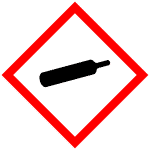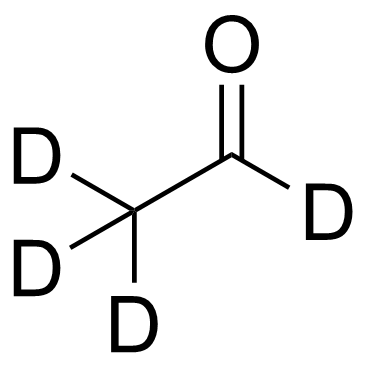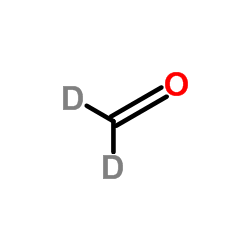ethylene-d4 oxide
Modify Date: 2024-01-04 13:05:43

ethylene-d4 oxide structure
|
Common Name | ethylene-d4 oxide | ||
|---|---|---|---|---|
| CAS Number | 6552-57-4 | Molecular Weight | 48.07720 | |
| Density | 0.896 g/mL at 25ºC | Boiling Point | 10.7ºC at 760 mmHg | |
| Molecular Formula | C2D4O | Melting Point | -111ºC(lit.) | |
| MSDS | USA | Flash Point | -4 °F | |
| Symbol |




GHS02, GHS04, GHS06, GHS08 |
Signal Word | Danger | |
| Name | 2,2,3,3-tetradeuteriooxirane |
|---|---|
| Synonym | More Synonyms |
| Density | 0.896 g/mL at 25ºC |
|---|---|
| Boiling Point | 10.7ºC at 760 mmHg |
| Melting Point | -111ºC(lit.) |
| Molecular Formula | C2D4O |
| Molecular Weight | 48.07720 |
| Exact Mass | 48.05130 |
| PSA | 12.53000 |
| LogP | 0.01660 |
| Vapour density | 1.52 (vs air) |
| Index of Refraction | 1.403 |
|
SECTION 1: Identification of the substance/mixture and of the company/undertaking Product identifiers Product name: Ethylene-d4 oxide REACH No.: A registration number is not available for this substance as the substance or its uses are exempted from registration, the annual tonnage does not require a registration or the registration is envisaged for a later registration deadline.
CAS-No.: 6552-57-4 SECTION 2: Hazards identification Classification of the substance or mixture Classification according to Regulation (EC) No 1272/2008 Flammable gases (Category 1), H220 Acute toxicity, Oral (Category 3), H301 Acute toxicity, Inhalation (Category 3), H331 Eye irritation (Category 2), H319 Germ cell mutagenicity (Category 1B), H340 Carcinogenicity (Category 1B), H350 Specific target organ toxicity - single exposure (Category 3), Respiratory system, H335 Chronic aquatic toxicity (Category 3), H412 For the full text of the H-Statements mentioned in this Section, see Section 16. Classification according to EU Directives 67/548/EEC or 1999/45/EC F+ Extremely flammableR12 For the full text of the R-phrases mentioned in this Section, see Section 16. Label elements Labelling according Regulation (EC) No 1272/2008 Pictogram Signal wordDanger Hazard statement(s) Extremely flammable gas. Contains gas under pressure; may explode if heated. Causes skin irritation. Causes serious eye irritation. Toxic if inhaled. May cause respiratory irritation. May cause genetic defects. May cause cancer. Precautionary statement(s) Obtain special instructions before use. Keep away from heat/sparks/open flames/hot surfaces. - No smoking. Avoid breathing gas. P305 + P351 + P338IF IN EYES: Rinse cautiously with water for several minutes. Remove contact lenses, if present and easy to do. Continue rinsing. Call a POISON CENTER or doctor/ physician. P410 + P403Protect from sunlight. Store in a well-ventilated place. Supplemental Hazardnone Statements Restricted to professional users. Other hazards - none SECTION 3: Composition/information on ingredients Substances Chemical characterization : Isotopically labeled Synonyms: Deuterated ethylene oxide Oxirane-D4 Formula: C2D4O Molecular Weight: 48,08 g/mol CAS-No.: 6552-57-4 No components need to be disclosed according to the applicable regulations. For the full text of the H-Statements and R-Phrases mentioned in this Section, see Section 16 SECTION 4: First aid measures Description of first aid measures General advice Consult a physician. Show this safety data sheet to the doctor in attendance. If inhaled If breathed in, move person into fresh air. If not breathing, give artificial respiration. Consult a physician. In case of skin contact Wash off with soap and plenty of water. Take victim immediately to hospital. Consult a physician. In case of eye contact Rinse thoroughly with plenty of water for at least 15 minutes and consult a physician. If swallowed Do NOT induce vomiting. Never give anything by mouth to an unconscious person. Rinse mouth with water. Consult a physician. Most important symptoms and effects, both acute and delayed The most important known symptoms and effects are described in the labelling (see section 2.2) and/or in section 11 Indication of any immediate medical attention and special treatment needed no data available SECTION 5: Firefighting measures Extinguishing media Suitable extinguishing media Use water spray, alcohol-resistant foam, dry chemical or carbon dioxide. Special hazards arising from the substance or mixture no data available Advice for firefighters Wear self contained breathing apparatus for fire fighting if necessary. Further information Use water spray to cool unopened containers. SECTION 6: Accidental release measures Personal precautions, protective equipment and emergency procedures Wear respiratory protection. Avoid breathing vapours, mist or gas. Ensure adequate ventilation. Remove all sources of ignition. Evacuate personnel to safe areas. Beware of vapours accumulating to form explosive concentrations. Vapours can accumulate in low areas. For personal protection see section 8. Environmental precautions Prevent further leakage or spillage if safe to do so. Do not let product enter drains. Discharge into the environment must be avoided. Methods and materials for containment and cleaning up Clean up promptly by sweeping or vacuum. Reference to other sections For disposal see section 13. SECTION 7: Handling and storage Precautions for safe handling Avoid exposure - obtain special instructions before use.Avoid contact with skin and eyes. Avoid inhalation of vapour or mist. Keep away from sources of ignition - No smoking.Take measures to prevent the build up of electrostatic charge. For precautions see section 2.2. Conditions for safe storage, including any incompatibilities Store in cool place. Keep container tightly closed in a dry and well-ventilated place. Store under inert gas. hygroscopic Specific end use(s) Apart from the uses mentioned in section 1.2 no other specific uses are stipulated SECTION 8: Exposure controls/personal protection Control parameters Components with workplace control parameters Exposure controls Appropriate engineering controls Avoid contact with skin, eyes and clothing. Wash hands before breaks and immediately after handling the product. Personal protective equipment Eye/face protection Face shield and safety glasses Use equipment for eye protection tested and approved under appropriate government standards such as NIOSH (US) or EN 166(EU). Skin protection Handle with gloves. Gloves must be inspected prior to use. Use proper glove removal technique (without touching glove's outer surface) to avoid skin contact with this product. Dispose of contaminated gloves after use in accordance with applicable laws and good laboratory practices. Wash and dry hands. The selected protective gloves have to satisfy the specifications of EU Directive 89/686/EEC and the standard EN 374 derived from it. Body Protection Complete suit protecting against chemicals, Flame retardant antistatic protective clothing, The type of protective equipment must be selected according to the concentration and amount of the dangerous substance at the specific workplace. Respiratory protection Where risk assessment shows air-purifying respirators are appropriate use a full-face respirator with multi-purpose combination (US) or type AXBEK (EN 14387) respirator cartridges as a backup to engineering controls. If the respirator is the sole means of protection, use a full-face supplied air respirator. Use respirators and components tested and approved under appropriate government standards such as NIOSH (US) or CEN (EU). Control of environmental exposure Prevent further leakage or spillage if safe to do so. Do not let product enter drains. Discharge into the environment must be avoided. SECTION 9: Physical and chemical properties Information on basic physical and chemical properties a) AppearanceForm: Compressed gas b) Odourno data available c) Odour Thresholdno data available d) pHno data available e) Melting point/freezingMelting point/range: -111 °C - lit. point f) Initial boiling point and 10,7 °C - lit. boiling range g) Flash point-20,00 °C - closed cup h) Evapouration rateno data available i) Flammability (solid, gas) no data available j) Upper/lowerUpper explosion limit: 99,90 %(V) flammability orLower explosion limit: 3,00 %(V) explosive limits k) Vapour pressure1.440 hPa at 20,00 °C 2.080 hPa at 30,00 °C 3.950 hPa at 50,00 °C l) Vapour densityno data available m) Relative density0,896 g/mL at 25 °C0,896 g/cm3 at 25 °C n) Water solubilityno data available o) Partition coefficient: n- log Pow: 0,300 octanol/water p) Auto-ignitionno data available temperature q) Decompositionno data available temperature r) Viscosityno data available s) Explosive propertiesno data available t) Oxidizing propertiesno data available Other safety information no data available SECTION 10: Stability and reactivity Reactivity no data available Chemical stability Stable under recommended storage conditions. Possibility of hazardous reactions no data available Conditions to avoid Heat, flames and sparks. Extremes of temperature and direct sunlight. Incompatible materials Alcohols, Alkali metals, Ammonia, Oxidizing agents, Chemically active metals, and its salts Hazardous decomposition products no data available In the event of fire: see section 5 SECTION 11: Toxicological information Information on toxicological effects Acute toxicity LD50 Oral - rat - 72 mg/kg LC50 Inhalation - rat - 4,00 h - 800 ppm Remarks: Lungs, Thorax, or Respiration:Other changes. Liver:Other changes. Kidney, Ureter, Bladder:Other changes. Skin corrosion/irritation no data available Serious eye damage/eye irritation Eyes - rabbit Result: Eye irritation - 6,00 h Respiratory or skin sensitisation no data available Germ cell mutagenicity In vivo tests showed mutagenic effects Carcinogenicity Possible human carcinogen IARC:No component of this product present at levels greater than or equal to 0.1% is identified as probable, possible or confirmed human carcinogen by IARC. Reproductive toxicity no data available Specific target organ toxicity - single exposure May cause respiratory irritation. Specific target organ toxicity - repeated exposure no data available Aspiration hazard no data available Additional Information RTECS: Not available burning sensation, Cough, wheezing, laryngitis, Shortness of breath, Headache, Nausea, Vomiting, Exposure to large amounts can cause:, Pulmonary edema. Effects may be delayed., Convulsions, Lung irritation, To the best of our knowledge, the chemical, physical, and toxicological properties have not been thoroughly investigated. SECTION 12: Ecological information Toxicity Toxicity to fishLC50 - Pimephales promelas (fathead minnow) - 84 mg/l - 96,0 h Persistence and degradability no data available Bioaccumulative potential no data available Mobility in soil no data available Results of PBT and vPvB assessment PBT/vPvB assessment not available as chemical safety assessment not required/not conducted Other adverse effects Harmful to aquatic life with long lasting effects. no data available SECTION 13: Disposal considerations Waste treatment methods Product Burn in a chemical incinerator equipped with an afterburner and scrubber but exert extra care in igniting as this material is highly flammable. Offer surplus and non-recyclable solutions to a licensed disposal company. Contaminated packaging Dispose of as unused product. SECTION 14: Transport information UN number ADR/RID: 1040IMDG: 1040IATA: 1040 UN proper shipping name ADR/RID: ETHYLENE OXIDE IMDG: ETHYLENE OXIDE IATA:Ethylene oxide Passenger Aircraft: Not permitted for transport Cargo Aircraft: Not permitted for transport Transport hazard class(es) ADR/RID: 2.3 (2.1)IMDG: 2.3 (2.1)IATA: 2.3 (2.1) Packaging group ADR/RID: -IMDG: -IATA: - Environmental hazards ADR/RID: noIMDG Marine pollutant: noIATA: no Special precautions for user no data available SECTION 15: Regulatory information This safety datasheet complies with the requirements of Regulation (EC) No. 1907/2006. Safety, health and environmental regulations/legislation specific for the substance or mixture no data available Chemical Safety Assessment SECTION 16 - ADDITIONAL INFORMATION N/A |
| Symbol |




GHS02, GHS04, GHS06, GHS08 |
|---|---|
| Signal Word | Danger |
| Hazard Statements | H220-H280-H315-H319-H331-H335-H340-H350 |
| Precautionary Statements | P201-P210-P261-P305 + P351 + P338-P311-P410 + P403 |
| Hazard Codes | F+: Highly flammable;T: Toxic; |
| Risk Phrases | R45 |
| Safety Phrases | 53-45 |
| RIDADR | UN 1040 2 |
| WGK Germany | 3 |
| Flash Point(F) | -4 °F |
| Flash Point(C) | -20 °C |
|
~% 
ethylene-d4 oxide CAS#:6552-57-4 |
| Literature: Canadian Journal of Chemistry, , vol. 30, p. 924,931 Org. Synth. Isotopes, , p. 1381 Journal of Chemical Physics, , vol. 19, p. 676,681 |
|
~% 
ethylene-d4 oxide CAS#:6552-57-4 |
| Literature: Journal of Chemical Physics, , vol. 19, p. 676,681 |
|
~% 
ethylene-d4 oxide CAS#:6552-57-4 |
| Literature: Journal of Physical Chemistry, , vol. 96, # 25 p. 10308 - 10315 |
| Precursor 2 | |
|---|---|
| DownStream 1 | |
| ethylene oxide-d4 |
| Oxirane-d4 |
| MFCD00144292 |
| ethylene-d4 oxide |




 CAS#:1664-98-8
CAS#:1664-98-8